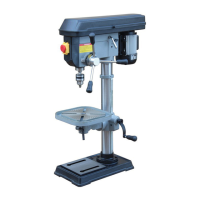16
Tips for use
Depth stop
The machine is equipped with a depth stop
whichisadjustedusingthelever(15).The
drilling depth can be measured using the
scale on the depth stop (2).
Chuck
Drills and cylindrical shafted tools up to
16 mm in diameter can be fastened in the
chuck with the chuck key (16).
Fastening the workpiece
The table has slots for fastening T-bolts and
drill vices to it.
Adjusting the table
The table can be moved up and down the
pillar when the locking lever on the back of
the table support (18) isundone.Adjustthe
table so that there is enough room between
the drill and the table for the workpiece. The
table can also be moved to the side if you
wishtoxaworkpiecedirectlytothebase
of the drill.
Ifyouwishtodrillatanangle,thetablecan
be tilted and the workpiece clamped to the
table. Undo the bolt (19) on the hinge of
the table (20). Move the table (17) to the
desired position and then tighten the bolt
(19) again.
Rpm/min and rate of feed
The drill is fed using the three feed levers (5). The spindle speed is determined by the size of
drill bit and the type of material being drilled.
The rate of feed is a crucial factor for the life of the drill bit and quality of result.
Follow these basic rules:
- Thebiggerthediameterdrillbit,thelowerthespeed.
- If the material being drilled is hard there is a natural urge to apply more pressure to
thedrill,buttoavoidoverheatingthedrillbitonsuchoccasionsoneshouldapplyless
pressureandlowerthespeedofthespindle.Moreover,thedrillbitneedstobecooledwith
a suitable cooling solution depending on the type of material.
When drilling into thin material be careful not to apply too much pressure and feed too quickly.
Whendrillingdeepholes(twicethediameterofthedrillbit)itcanbedifculttogetridofthe
swarf,whichcanleadtothedrillbitbecominghot.Itisthereforeagoodideatoreducethe
feed rate and remove the swarf by lifting the drill out of the hole from time to time. When drill-
ingholeslargerthan8mmyoushouldrstdrillapilotholesothetipofthedrillbitisnotover-
loaded. In this way you stop the tip of the drill from being overloaded.

